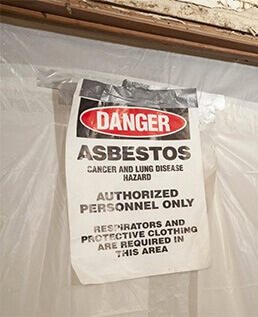What's the Difference Between Friable and Non-Friable Asbestos?
Posted in Asbestos Removal, on August 23, 2021
Despite being listed now as a hazardous substance, asbestos was once a widely used building material with various applications, before its carcinogenic effects were known. As a result of being ubiquitous, asbestos removal in Mississauga is still required today as the mineral continues to be uncovered in residential and commercial properties. If asbestos is exposed and not abated the repercussions can be severe. When asbestos microfibrils are inhaled they remain in the lungs, causing microscopic cuts in the tissue and chronic inflammation that can result in severe diseases. Many homes and commercial buildings constructed before 1990 are in need of asbestos testing in Mississauga, as they often include asbestos in the following materials:
- Textured coatings
- Pipe insulation
- Boiler insulation
- Loose-fill insulation
- Popcorn ceilings
- Soundproofing materials
- Roofing felts
- Certain types of adhesives
- Ceiling tiles
- Vinyl floor tiles
- Some types of paints
- Gaskets in furnaces and stoves run by fossil fuels
- Cement
- Vent duct connections
- Caulking
 Because asbestos is present in so many materials and they go through quite a lot of wear and tear over the years, many older homes require asbestos removal in Mississauga. However, just because some material contains asbestos it doesn’t mean that it is dangerous, as not all asbestos-containing materials (ACMs) are equal in terms of health safety. Asbestos microfibrils pose a risk once they are airborne, so there is a great difference between friable and non-friable asbestos.
Because asbestos is present in so many materials and they go through quite a lot of wear and tear over the years, many older homes require asbestos removal in Mississauga. However, just because some material contains asbestos it doesn’t mean that it is dangerous, as not all asbestos-containing materials (ACMs) are equal in terms of health safety. Asbestos microfibrils pose a risk once they are airborne, so there is a great difference between friable and non-friable asbestos.
Friable Asbestos
According to the definition: “Friable asbestos-containing material is any material that contains more than one percent asbestos by weight or area, depending on whether it is a bulk or sheet material and can be crumbled, pulverized, or reduced to powder by the pressure of an ordinary human hand”. This type of asbestos is considered hazardous and health-threatening by Canadian law, and as such, it needs professional handling. Even the slightest damage to friable ACMs can release the carcinogenic microfibrils and create a threat of exposure, so their abatement requires following strict safety procedures and methodologies.
Materials that fall into this category often include pipe insulation, roofing felts, loose-fill insulation, vent duct connections, ceiling tiles, furnace and stove gaskets, asbestos adhesives and paints, and caulking. Asbestos removal in Mississauga may be required depending on the state of these materials in your home, their concentration, and whether they can be encapsulated.
Non-Friable Asbestos - Risks, Response
Non-friable ACM is defined as: “Any material that contains more than one percent asbestos, but cannot be pulverized under hand pressure”. This type of ACMs is often found in vinyl floor tiles, asbestos-containing cement, vinyl wall coverings, older freezers and boilers. Because asbestos is usually tightly sealed in these materials, the chance of microfibril exposure is minimal. Although non-friable ACMs are considered safe, it is not recommended to disturb them in any way because they too can become friable.
As we can see, it can be difficult to differentiate between these two types. To ensure complete safety, the best choice is to avoid handling ACMs on your own and call a professional. Canada’s Restoration Services offer a wide range of asbestos abatement services. The experienced staff of CRS is certified and trained to perform professional asbestos testing and removal in Mississauga, and is always ready to make your home a safer, healthier place.
Book your inspection today with the experts at CRS.







